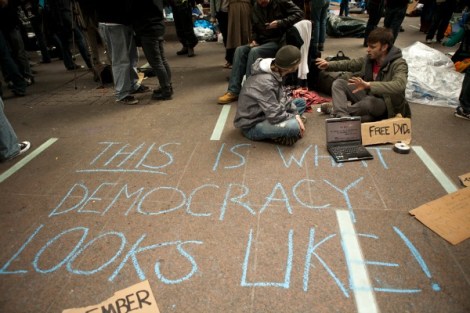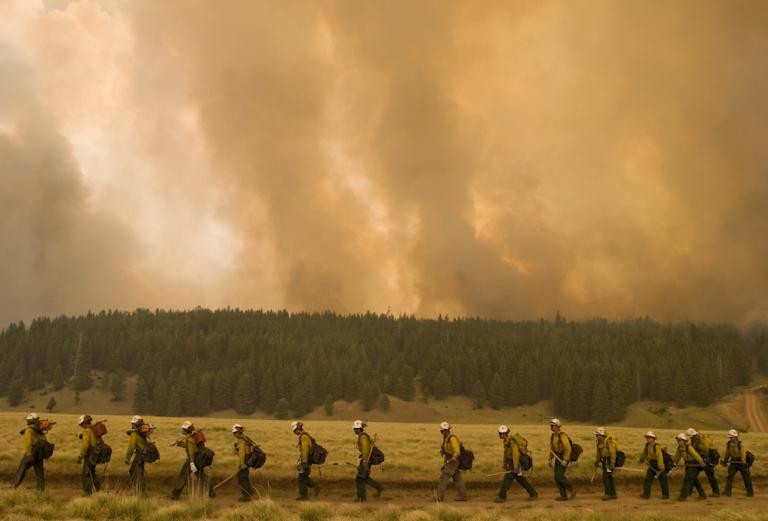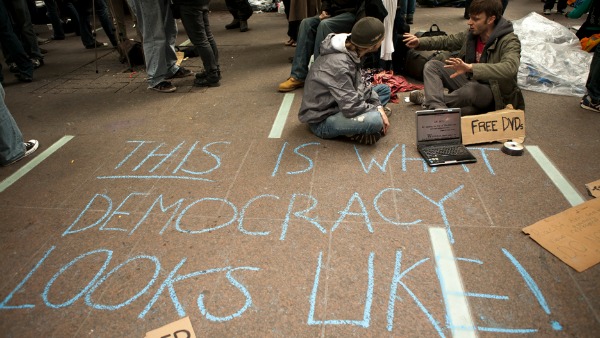From New York’s Zuccotti Park to Egypt’s Tahrir Square, popular uprisings of the last few years have often been credited to the organizing power of digital social networks like Twitter and Facebook. But shared public spaces in dense urban areas have a lot more organizing power than hashtags or retweets, and there’s new research to back that up.

The Urban Affairs Review paper “Walk and Be Moved: How Walking Builds Social Movements” by Brian Knudsen and Terry Clark underscores how dense city living exposes residents to new ideas and connections, and in turn fosters the creation of social movement organizations. The authors (Knudsen works at Urban Innovation Analysis, a Chicago design firm, and Clark is a sociology professor at the University of Chicago) base their research on the interaction between the urbs — our physical infrastructure, our streets, our parks, our commerce — and the civitas — the people who give those places meaning collectively.
Knudsen and Clark say they are “the first to discover and analyze electronic unpublished data for environmental, human rights, and other types” of social movement groups, and compare them to how city spaces are used and lived. Their analysis shows that it’s not just the existence of those shared public spaces, but the way we use them that contributes to making a city more politically active. Specifically, a more active city is one that uses its two feet.
“The study provides substantial evidence that it is not just density, or the crowding together of people in urban areas, that shapes political and social activism, but the direct engagement of the city through walking,” Richard Florida writes at Atlantic Cities.
We’ve intuitively known that cities spawn social movements for a really long time. It’s been 45 years since Henri Lefebvre wrote about our “right to the city” — our right, that is, to “demand a transformed and renewed access to urban life.” Lefebvre wasn’t the only, or the first, one to point this out. (Hey Jane Jacobs! Hey Aristotle!) But these ideas are especially relevant in light of the last few years of global political action.
“In our historic moment, social grievances are inextricably tied to urban living,” Marc Tracy writes about the recent uprisings in Brazil at the New Republic (uprisings that, it should be noted, were sparked by an attempt to raise bus fares). “And since the characteristic attribute of a city is density and the characteristic attribute of density is the flinging together of people from different walks of life, Brazil’s protests have engaged a broad swath of the population.”
Brazil made the right to the city national law in 2001. But do the same forces come to bear in U.S. cities? Stateside, cities seem more concerned about attracting “new talent” than fostering social justice these days. Talk among urbanists is more about bike lanes and coffee shops than lowering transit fares.
According to the study’s authors, “walking effects are larger than income, local rent, or racial diversity.” But it seems ill-advised to rule out those factors entirely, especially when our cities are in flux, and when the authors are using data from the year 2000. Since then, many U.S. city centers have grown more affluent and white, while the formerly cloistered, non-walkable suburbs have become more poor and brown.
What might those shifts mean for the future of urban activism? A diversity of population and ideas is what makes the real magic behind walkability — not just the walking itself. People have to be exposed to the breadth of the human condition if they might be motivated to change it. Will social and environmental justice organizations sustain in dense neighborhoods that become richer, and more homogenous? Can that diversity of ideas sustain without a diversity of people?
Put another way, will new city residents still be motivated toward social and environmental justice issues, or will they be content to sip soy lattes and ride bikes while donning very hip-looking helmets?
Ultimately — ideally! — if these dense, walkable places can accommodate newcomers without losing sight of longtime residents, everyone stands to benefit. To do that, though, we’ll need to maintain a diverse political dialog — in the public squares, of course.




